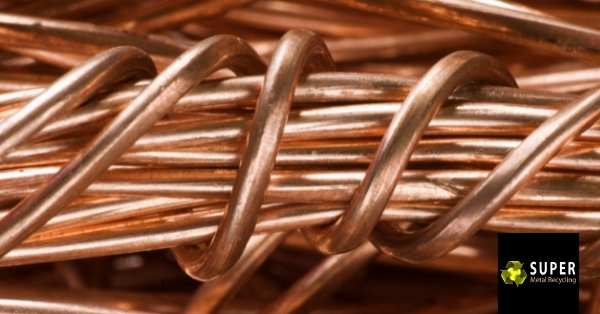If you’re considering a trip to the scrapyard, it’s important that you know how to separate your metals. Metal recycling centers near you will determine your scrap’s value based on the least valuable metal in your container. So when you keep your metals separate, you’ll secure the best payment possible.
Unfortunately, separating metals can be a tricky proposition, especially when you are dealing with metals that look alike, such as copper and brass. In order to help you maximize your return, the experts at Super Metal Recycling have put together a closer look at telling copper from brass.
Copper vs. Brass
It should come as no surprise that copper and brass are difficult to tell apart; after all, without copper, there would be no brass. While copper is a naturally occurring element, brass is an alloy, composed of a combination of copper and zinc. The percentage of copper in a given sample of brass will vary but in general more copper means more value.
On the whole, both metals have very similar characteristics and are prized for their durability, malleability, and general appearance. Ironically, though brass is less valuable as scrap metal, consumers appreciate its gold-like appearance and it tends to maintain a cleaner overall veneer. Both metals are resistant to rust but unless properly sealed, copper can be prone to corrosion, as famously displayed by the green hue of the Statue of Liberty.
As far as their general value, both copper and brass are a good bet at any scrap yard.
Telling the Two Apart
While copper and brass may be indistinguishable at first glance, telling the two apart is really quite simple, and it often comes down to a color test. The previously mentioned golden sheen of some brass may make for easy identification in some cases, but even when contrast is lacking, if your metal tends towards red it is likely copper—or at the very least, higher-value “red” bronze—and if it appears yellow it is most likely brass. If you can’t tell immediately, perhaps due to an item’s age or weathering, a nail file will go a long way towards identifying your scrap. Simply give the metal a quick scratch with the file and see if it shows as red or yellow.
Additionally, context will go a long way towards answering the question of “is it copper or brass?” While the similar makeup of these two metals will lead to some crossover in usage—both are found in construction, demolition, electrical transmission, and plumbing—some cases are unique to specific metals. For example, expect to find brass in the following:
- Musical instruments
- Doorknobs
- Bed frames
- Ammunition shells
- Radiators
- Light fixtures
Copper, on the other hand, is more likely to be seen in:
- Medical equipment
- Jewelry
- Machinery
- Sculpture
Get Help From the Recycling Experts at Super Metal Recycling
At the end of the day, any scrap metal you bring to the recycling yard is going to help the environment as you put materials back into circulation and reduce the demand for natural resources. And whether you have copper or brass you can get a nice paycheck when you bring scrap metal to the experts at Super Metal Recycling. If you have other scrap metal on hand, Contact us. Whatever you’re scrapping, our team proudly offers up-to-date prices so you get a fair payout, and we also offer convenient services to make scrapping as simple as possible.
Super Metal Recycling is based in Dandenong, Victoria, servicing for all types of Scrap Metals, Unwanted Cars, Junk Cars, Free Car Removals, Wrecked Cars, Smashed Cars, throughout Melbourne Metro areas. We offer cash for Scrap Cars, specialise in Old Car Removals, Car Wreckage Removal, Recycling of old cars and Scrap Metal Recycling.
If you are at Braeside, below is the best way to visit us.
Super Metal Recycling
345 Frankston – Dandenong Road, Dandenong South VIC 3175
(03) 9706 4909
* Find us on Google Map


Recent Comments